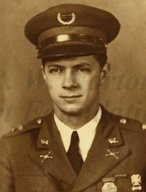
|

|
|
|
|
William was born on a plantation in Washington County, Mississippi, as one of four children to Paul Lawrence Banks and Nellie Mead Banks. He also remembers fondly an African-American woman, Judy Garner, who worked in the household and took care of him as an infant. At age four, William fell victim in the flu epidemic of 1918, and spent two weeks in a Vicksburg hospital before returning to the family home at Esperanza Plantation. He calls living on the plantation, where his father was manager, as "a great life." Besides hunting with their father, an avid sportsman, he and his brothers worked. William carried water to workers in the fields, earning fifty cents a day. He also sold a newspaper, the New Orleans Item, when the family lived on the Dawson Plantation near Tchula, Mississippi. The elder Banks moved the family to Tunica, Mississippi, where he sold farm machinery, then moved again to Helena, Arkansas in 1927. There, his father was superintendent of the county farm and served as a deputy sheriff until his death in 1939. His mother went to work as a secretary, stenographer, and bookkeeper at the Ford dealership. Around "1925 or `26" he and another brother raised an acre of cotton. "I could never pick over a hundred pounds a day, but the real good hands that worked in the fields...could pick five or six hundred pounds a day," he recalls. He also worked in drugstores. William graduated from Helena High School in 1934. As a solicitor for Allenburg Cleaners for two years, he earned fifteen dollars in salary and ten per cent of any dry cleaning business he generated. After earning tuition money he entered Mississippi State University, where he joined ROTC and was captain of the school's rifle team. Graduating in 1940 with a degree as an agriculture engineer, William was selling chemical fertilizers for New York-based Barrett Company when the U.S. Army drafted him. He entered service on October 21, 1940. Stationed at Fort Du Pont in Delaware as a second lieutenant, he served as communications officer for the 21st Artillery. He requested and was granted service in Hawaii, where he would remain throughout the war. By late July of 1941 he was stationed at Fort Kamehameha, located between Hickam Field and Pearl Harbor, and assigned as commander of Headquarters Battery and Combat Training for 55th Coast Artillery. He later became commander of Battery F of the 15th Coast Artillery, which included two turrets removed from the US Saratoga and mounted on Salt Lake Crater in Hawaii. When Japanese attacked Pearl Harbor, his unit fought back with two, thirty-caliber machine guns, originally placed at his battery as an anti-sabotage measure. He recalls waking about 7:45 a.m. to "some racket," he says. "Then, boy, all of a sudden a big wham! I suppose that was when the Arizona got hit by the torpedoes." He sprinted outside in his pajamas. "I went out in the back yard and all these planes flying over, I just couldn't imagine what it was," he says. "Then I saw those red circles on their wings." Dressing quickly, he was running towards his battery when a lieutenant roared up in an automobile. William jumped on the running board. "He went flying down the road and here came a truck, and boy, it barely missed me on that running board," he recalls. "That was the closest I came to getting killed in the war." He saw "forty or fifty soldiers" dead from Japanese machine gun fire at Hickam Field. One Japanese Zero roared past him "twenty feet over our heads" and crashed into an ordnance building, killing four soldiers. He recalls one as "the first casualty I saw during the war." Returning to the states on temporary duty in October of 1945 he married Jean Carter Hitch, whom he had met during college. She was working in Washington, D.C. with the Signal Corps, decoding Japanese messages. (They would have four children, five grandchildren, and six great-grandchildren.) Returning to Hawaii, where by then shore batteries had been deemed obsolete, he was appointed as adjutant for the 745th Military Police Battalion. For performance of his duties, he received a Superior Efficiency Report, a step above an excellent rating. A year later William returned to the States and was discharged at Camp Shelby near Hattiesburg, Mississippi. He remained in the reserves, however, eventually attaining the rank of colonel. Meanwhile he worked as a surveyor for a brother, an engineer for Delta Pine Land Company. He then joined a younger brother and opened several laundromats in New Orleans. After a fifteen-year stint in the heating and air conditioning business, he was a manufacturer's representative for plumbing supplies for several companies. He then served as a driver for three years for George Williams of the TL James Company. Retired and living in Metairie, Louisiana, William and Jean moved to Shreveport when Hurricane Katrina hit. |


